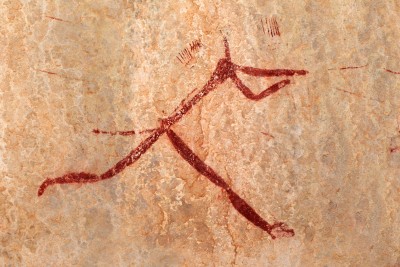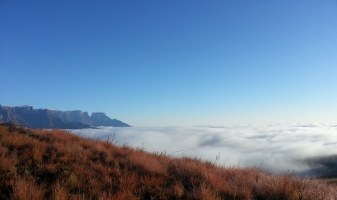History and Culture | World Heritage Site
-
 The Drakensberg range can be divided into three parts.
The Drakensberg range can be divided into three parts.1. Northern Drakensberg which comprises Royal Natal Nature Reserve (Amphitheatre, Chain Ladder, Mont-aux-Sources), Mnweni Nature Reserve (Mnweni, Ntonjelane, Ifidi and Icidi valleys) and Cathedral Peak Nature Reserve (Ndumeni, Organ Pipes, Mdedelelo Wilderness Area, Didima).
2. Central Drakensberg which comprises Monk's Cowl Nature Reserve (Mlambonja and Mdedelelo Wilderness Area's, Champagne Castle), Injisuthi Nature Reserve (Mafadi, Marble Baths), Giant's Castle Nature Reserve (Bannerman Pass), Highmoor Nature Reserve (Caracal & Aasvoelkrans Caves) and Kamberg Nature Reserve (San Rock Art Centre, Flyfishing)
3. Southern Drakensberg which comprises uMkhomazi Nature Reserve (kaNtuba), Lotheni Nature Reserve (Jacobs Ladder, Gelib Tree), Vergelegen Nature Reserve (Mzimkhulu Wilderness Area, Mzimkhulwana Nature Reserve), Garden Castle Nature Reserve (Rhino, Hodgson's Peak), Cobham Nature Reserve (Sani Top, Sani Pass) and Bushmans Nek Nature Reserve (Sehlabathebe National Park, Thamathu).
-
 Both the Zulu name, uKhahlamba (barrier of spears) and the Afrikaans name Drakensberg (dragon mountain) fit the formidable horizon created by the range. A massive basaltic cap set on a broad base of sedimentary rocks belonging to the Stormberg series of 150 million years ago, the mountains are South Africa's main watershed.
Both the Zulu name, uKhahlamba (barrier of spears) and the Afrikaans name Drakensberg (dragon mountain) fit the formidable horizon created by the range. A massive basaltic cap set on a broad base of sedimentary rocks belonging to the Stormberg series of 150 million years ago, the mountains are South Africa's main watershed.This region is one of the most important archaeological areas in Southern Africa. Archaeological sites from the Early, Middle, and Late Stones Ages and the Late Iron Age indicate that human occupation in this mountain region may extend over the last 1 million years.
The earliest recorded occupation of the Drakensberg Park is from the Mesolithic period, at least 20 000 BP (Note Early dates resulting from scientific dating techniques are expressed as "years BP" - ie years before the conventional date of 1950 on which all radiocarbon dating is based.) It was, however, the Neolithic settlers who arrived around 8 000 years BP that were the ancestors of the San. They were hunter-gatherers, often living in caves or rock-shelters. There were probably never more than a thousand people living in the area of the modern Park, and so they left no traces on the landscape beyond their rock-art.
Iron Age farmers moved into the foothills to the east of the main escarpment in the 13th century CE, or perhaps a little earlier, bringing domesticated cattle and sheep into the region. By the late 16th century there were cattle-herding people, the Zizi to the north and the Tholo to the south, living in permanent settlements in areas adjacent to the northern and central Drakensberg region. At first their relationships with the San were peaceable, but from the early 19th century with the rise of Zulu power to the south, under the leadership of Shaka, successive waves of people were forced to migrate northwards into the Drakensberg.
Large areas in the foothills of the Drakensberg were settled by the Voortrekkers from 1837 onwards. They farmed cattle and later sheep on the good grazing lands until the 1930s, and also hunted the game animals of the region remorselessly, bringing them into conflict with the San. To protect their flocks and herds against San raids, the Natal Government settled Bantu-speaking farmers in order to seal off the San raiders. Punitive raids during the 1860s and 1870s led to the eventual destruction of the San communities, upsetting the balance that had existed for thousands of years between the indigenous people and their sustainable use of the natural resources of the region.
-
 The Maloti-Drakensberg Park is a transboundary site composed of the uKhahlamba Drakensberg National Park in South Africa and the Sehlathebe National Park in Lesotho.
The Maloti-Drakensberg Park is a transboundary site composed of the uKhahlamba Drakensberg National Park in South Africa and the Sehlathebe National Park in Lesotho.Maloti-Drakensberg Park was established on 11 June 2001 by linking the Sehlabathebe National Park in the Kingdom of Lesotho and the uKhahlamba Drakensberg Park in KwaZulu-Natal, South Africa. The highest peak is Thaba Ntlenyana rising to 3.482 m.
The merged park includes Golden Gate Highlands National Park, QwaQwa National Park and Sterkfontein Dam Nature Reserve, (Free State); uKhahlamba Drakensberg Park and Royal Natal National Park, (KwaZulu-Natal) and Sehlabathebe National Park, (Lesotho).
The park is situated in the Drakensberg Mountains which form the highest areas in the sub-region, and supports unique montane and sub-alpine ecosystems. These ecosystems hold a globally significant plant and animal biodiversity, with unique habitats and high levels of endemism. The park is also home to the greatest gallery of rock art in the world with hundreds of sites and many thousands of images painted by the Bushmen (San) people.
The transfrontier conservation area was conceived as a Peace park, covering about 8 113 km², made up of 5 170 km² (64%) in Lesotho and 2 943 km² (36%) in KwaZulu-Natal.
The Sehlabathebe National Park is located in the Maloti Mountains in Qacha's Nek District, Lesotho, and is part of the larger Maloti-Drakensberg World Heritage Site.
The park also has some of the most beautiful rock paintings in the world. There are over 30 000 painted images in 520 rock shelters and many experts use the area to study the history of the people who painted the pictures. Most of the paintings were made about 4 000 years ago by the San people and show different animals, people and many other subjects. They represent the spiritual life of the San, who don’t live in the area anymore.
-
 Originally roaming freely throughout southern Africa, the San were forced to take refuge in the mountains with the 13th century migration of the Bantu-speaking people into the region and later, European colonisation. San culture disappeared from the Drakensberg at the end of the 19th century. But the paintings remained. The artists used red, orange, yellow, black and white, derived from mixing clay, burnt wood and ochre oxides.
Originally roaming freely throughout southern Africa, the San were forced to take refuge in the mountains with the 13th century migration of the Bantu-speaking people into the region and later, European colonisation. San culture disappeared from the Drakensberg at the end of the 19th century. But the paintings remained. The artists used red, orange, yellow, black and white, derived from mixing clay, burnt wood and ochre oxides.The paintings have a documentary aspect, showing the San interacting with one another and their environment. Hunting scenes are common. The subject matter changed with the arrival of the settlers from the north and the colonists from Europe. The oldest painting on a rock shelter wall in the Drakensberg dates back about 2 400 years, but paint chips at least a thousand years older have also been found.



